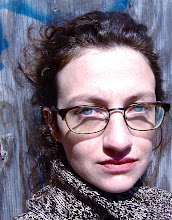Pause For A Brief Moment Of Covetousness
These Iranian miniatures (gouche on cardboard), illustrating scenes and ideas from Hafez, are really, really beautiful. I admire the way the artist, Farah Ossouli, manages to suspend the pastoral, classical figures within abstract, concealing blocks of color: the people are framed, but also weighed in upon, but the whole composition is balanced anyhow.
Oh, I'm botching this description. Here, look at number 6 in the series, and then number 31 in the series. Whatever it is that those two have in common is what I like a lot here.
[Hat tip to Kriston]
Oh, I'm botching this description. Here, look at number 6 in the series, and then number 31 in the series. Whatever it is that those two have in common is what I like a lot here.
[Hat tip to Kriston]



10 Comments:
No, I think you described their charms -- made somehow precious, in the good sense, by the framing and the miniaturization -- well, from what I can see on my screen.
I am attracted to and awed by this type of art. It gives me a sort of calming, sustained thrill in the pit of my stomach -- like observing the Japanese tea ceremony.
Joseph Cornell's shadow boxes and small iconographic religious paintings give me the same effect.
If Guernica or the Sistine Chapel ceiling could be placed in a water droplet and viewed through a microscope, I would REALLY look at them.
In my next life, the one after the next three, because I'm such a horrible procrastinator, I wish I could paint something besides the living room wall, which I will get to in the very next life.
I would do a series of miniature paintings of American teenagers sitting in their cars at traffic lights. The framing would be the outline of the car windows and they would be in vaguely iconographic poses.
Then, other people, with expressions on their faces as we think about the stuff we think about (mundane grievances and ecstatic plans) as we sit in traffic.
Are those squid in the sky in six?
Thanks for pointing me to Joseph Cornell's miniatures and assemblages, John. I think I've seen a few of them on exhibit before, but I hadn't really connected them with a single name. That happens to me a lot with art.
I suspect that part of my attraction to Ossouli's miniatures, part of the calming effect they have, is the dominance of blue. I'm a gigantic sucker for blue art.
Rilkefan, I don't think those are supposed to be squid--probably squiggly birds in flight, as I think I've seen before--but if it makes you happy to think it a tableau of flying squid with carpet, farbeit from me to disabuse you!
It's lucy in the sky with squid.
By the way, "small iconographic religious paintings" are not Cornell's work.
Separate thought, badly expressed.
Perhaps, Mr. Thullen, perhaps. I wouldn't say that Cornell's work were entirely separate from the tradition of "small iconographic religious paintings"!
I do think that one could go a bit mad painting miniatures. To do it properly and not go blind, you'd need a powerful light source, a large magnifying lens, and very fine brushes, the latter of which would continuously clot and break and generally drive you crazy. Since you'd be viewing the minature in at least 20x magnification, you might obsess over imperfections that normal viewers wouldn't be able to see, imperfections that might in fact represent your medium's limitations.
Speaking of miniatures, I'm also a gigantic sucker for Russian lacquer boxes. I grew up with this book--you can see an image here. When I write "sucker for," I don't actually mean that I, um, own any of these items.
Some Dali paintings are, I believe, nearly small enough to be miniatures, perhaps apropos for the obsessiveness they show.
I don't know quite what it is, maybe the inexplicable rash of freshman papers on Dali I had for a while there, but I've totally lost my former ability to enjoy his work, even though some of it is blue.
I think I found him interesting at one time but his work doesn't wear well because it's so often the same schtick - objects that clump to look sort of like something else, busy nightmares that become tiresome. I do admire his draftsmanship, and maybe this or this is great art. And, well...
The first and third paintings--yes. They have tremendous power and skill and, more rare for Dali, a compositional unity. I haven't seen the second one close enough to say one way or another.
He really is an extraordinary painter, but I see so much bad faith in his work that I tend to get frustrated with him. I don't mean ideological bad faith, per se: just schlock and willful, lazy obscurantism. It's heartbreaking to see stupid paintings from someone so ridiculously gifted.
Post a Comment
<< Home